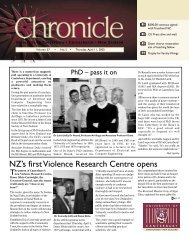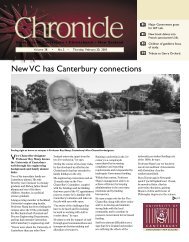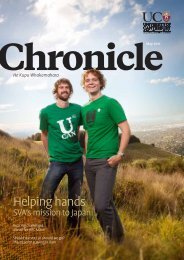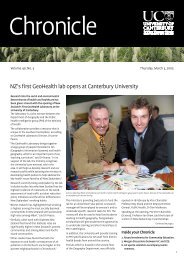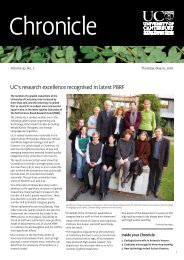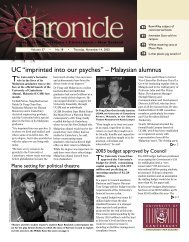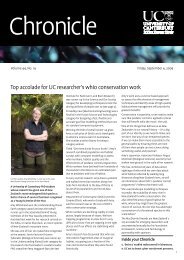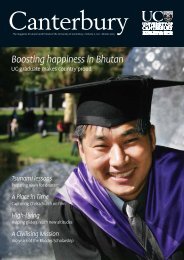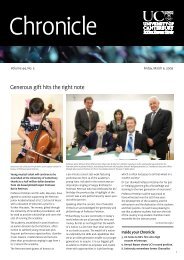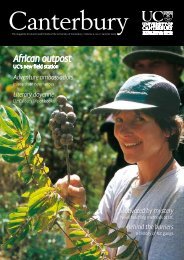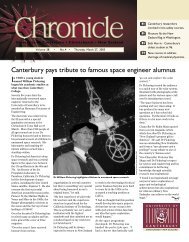Download - Communications and Development Department ...
Download - Communications and Development Department ...
Download - Communications and Development Department ...
Create successful ePaper yourself
Turn your PDF publications into a flip-book with our unique Google optimized e-Paper software.
supercomputer to run an advancedmeteorological wind modelling system.Environmental Prediction Systems (EPS),which has been developed at UC’s Centrefor Atmospheric Research, interprets globalweather data to run sophisticated threedimensionalmodels of the atmosphere athigh resolution in complex terrain.The data is derived from a broad range ofmeasurement systems such as surfacestations, satellite <strong>and</strong> balloon soundings,ocean buoys, ships <strong>and</strong> aircraft.The models, which require significantcomputing power, are capable ofproducing accurate predictions of windspeed <strong>and</strong> direction to identify sitessuitable for wind farms.The system significantly reduces the cost<strong>and</strong> time delays associated with assessingthe wind resource by minimising theneed for on-site monitoring. It has manyapplications, from prospecting for the bestwind farm sites, to short-term operationalforecasting of wind farm output.The EPS is being commercialised throughan agreement between Canterprise,the University’s commercial arm, <strong>and</strong>consulting engineering companyConnell Wagner.The atmospheric models can also be used topredict air pollution dispersion in support ofa major project, Protecting New Zeal<strong>and</strong>’sClean Air, funded by the Foundation forResearch, Science <strong>and</strong> Technology.Sturman says the supercomputer is playinga significant role in his work.“Internationally, high-powered computingis the fundamental requirement for anyserious modelling of the three-dimensionalproperties of the atmosphere, whether it isfor short or longer term applications.“The high performance computersystem here at Canterbury providesgreatly improved processing speed <strong>and</strong>significantly enhances the quantity <strong>and</strong>quality of our research output.”BULLET TRAIN FOR IDEASBy Jeanette ColmanThe University of Canterbury is part ofa new super high-speed network thatdelivers data 10,000 times faster than ahousehold broadb<strong>and</strong> connection.In August, the University’s HumanInterface Technology Lab (HIT Lab NZ)became the South Isl<strong>and</strong>’s first “point ofpresence” for KAREN — the Kiwi AdvancedResearch <strong>and</strong> Education Network.Donald Clark, who heads Research<strong>and</strong> Education Advanced Network ofNew Zeal<strong>and</strong>, the organisation thatestablished KAREN, describes the networkas a “bullet train for ideas”.“It will carry incredible amounts ofinformation at 10 gigabits a secondbetween researchers within New Zeal<strong>and</strong>,<strong>and</strong> to the outside world.”Carrying data 20,000 times faster th<strong>and</strong>ial-up internet, KAREN can deliver10Gbytes of data to a researcher’scomputer in just 13 minutes. The same10Gbytes would take 22 hours to transfervia the commercial internet.It is a far cry from UC’s first internetconnection 20 years ago.In 1985, the Computer Centre, as it wasthen known, got a connection from itsPrime 750 computer to PACNET, the PostOffice network.The following year Robert Biddle, aPhD student in the Computer Science<strong>Department</strong>, used the PACNET connectionto connect to the University of Waterlooin Canada where he had earlier been astudent. This connection allowed thetransfer of email between Canterbury’sComputer Science <strong>Department</strong> <strong>and</strong>Waterloo’s Maths <strong>Department</strong> <strong>and</strong>beyond.“At 10 kilobits a second, PACNET wasabout a million times slower thanKAREN,” says senior programmer TonyDale (Computer Science <strong>and</strong> SoftwareEngineering).“Because the PACNET connection only ranovernight, we received email <strong>and</strong> newsjust once a day,” Dale recalls.“There was no World Wide Web back then,but we could email download requests toa server, that would then email us backthe requested file.”Thanks to KAREN, Canterbury researchersnow have the world closer than everbefore.HIT Lab NZ Director Mark Billinghurstsays KAREN makes it possible forresearchers to live locally but do researchon a global scale.“A high-speed network means anycomputer in New Zeal<strong>and</strong> can be at mydesktop <strong>and</strong> any person in the world canbe at my desk.”Clark estimates that the Government’s$43 million investment in KAREN couldreturn as much as a half a billion dollarsin research value.KAREN will enable New Zeal<strong>and</strong>geologists <strong>and</strong> geophysicists to accesssensor data from fault lines in the UnitedStates; permit 3D modellers to collaborateon international mapping projects; <strong>and</strong>allow students in New Zeal<strong>and</strong> lecturetheatres to participate in interactivevideo lectures with experts anywhere inthe world.Summer 2006 15



